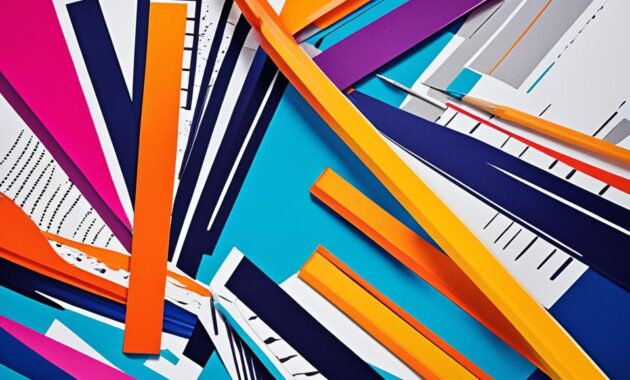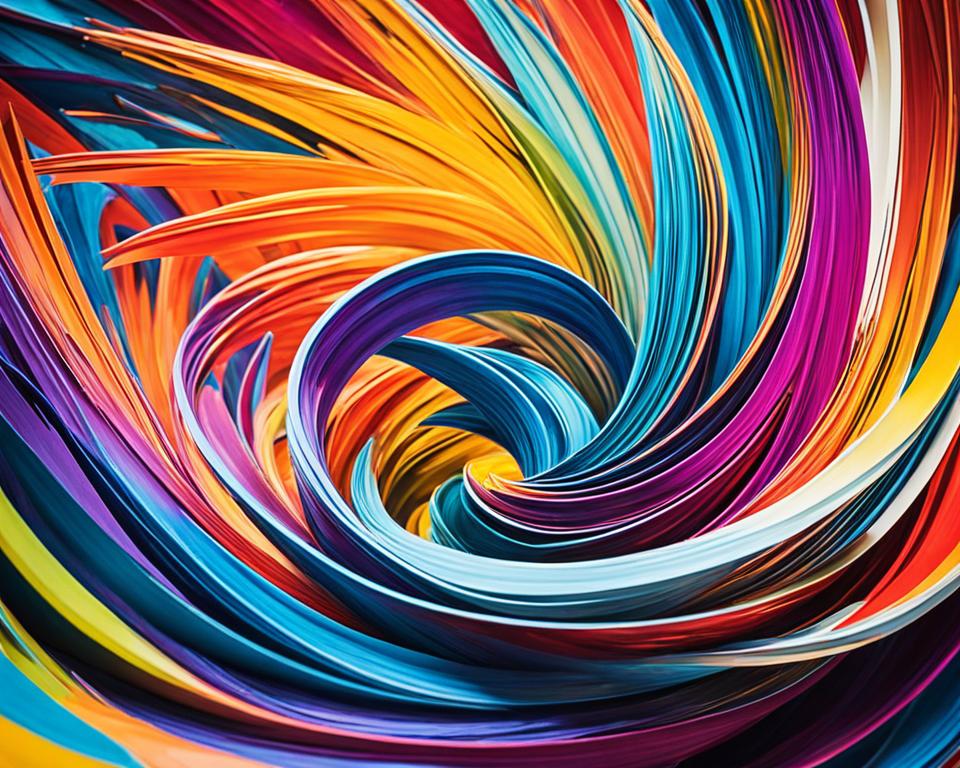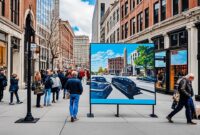Embark on an exhilarating journey through the captivating world of visual arts. This realm is filled with diverse mediums, techniques, and artistic expressions. Each element has the power to ignite the imagination and captivate the senses. From the vibrant brushstrokes of painting to the intricate sculptures that give form to creative visions, the visual arts offer endless possibilities for exploration and self-expression.
Key Takeaways
- Discover the boundless potential of visual arts to inspire and captivate
- Explore a diverse range of mediums, including painting, sculpture, photography, and more
- Unleash your creativity and find new ways to express yourself through visual art
- Appreciate the power of visual arts to convey emotions, tell stories, and transform spaces
- Embark on a journey of artistic discovery and immerse yourself in the world of visual arts
Embracing the Realm of Visual Arts
The visual arts span a vast array of creative disciplines, each providing distinct avenues for artistic expression. Whether your preference lies with the vibrant hues of a painting, the intricate details of sculpture, or the dynamic frames of photography, the visual arts offer a rich tapestry to explore. This realm invites you to immerse yourself in the limitless expanse of creativity and harness the transformative essence of visual expression.
Visual arts encompass a diverse range of mediums and forms, including but not limited to:
- Painting
- Sculpture
- Photography
- Drawing
- Printmaking
- Ceramics
- Installation art
- Performance art
- Design (graphic, product, and more)
Each discipline within the visual arts enables individuals to tap into their creativity and express themselves artistically. Whether through the dynamic brushstrokes of painting, the meticulous craftsmanship of sculpture, or the evocative compositions of photography, the visual arts provide an expansive canvas for delving into the human experience and emotion.
Exploring the visual arts unveils their profound impact on conveying ideas, evoking emotions, and challenging perspectives. From the refined techniques of historical masters to the innovative approaches of contemporary artists, this domain showcases the immense potential of human creativity.
“Art is not what you see, but what you make others see.” – Edgar Degas
For both aspiring artists and enthusiasts, engaging with the visual arts can unlock new avenues for self-expression, personal development, and a heightened appreciation for the world’s beauty. Embark on this visual journey and allow your creativity to flourish.
Painting: A Journey of Colors and Emotions
Painting stands as a timeless art form, enabling artists to express emotions, narrate stories, and encapsulate the world’s essence. It’s a medium that encourages exploration and self-discovery through the delicate brush movements and the bold use of pigments.
Mastering the Art of Brushstrokes
Brushstroke mastery is crucial in painting. Each stroke reflects the artist’s vision, style, technique, and emotional bond with the canvas. Artists refine their skills by experimenting with various brushes, paint consistencies, and application methods. This experimentation leads to a wide array of textures and effects.
Exploring Different Painting Styles
The realm of painting styles is vast, offering endless avenues for artistic expression. From abstract expressionism’s fluid spontaneity to photorealism’s meticulous realism, artists can explore and develop their unique approaches. This diversity allows for boundless creativity.
- Realism: Capturing the world with precise detail and accuracy
- Impressionism: Focusing on the fleeting moments of light and color
- Expressionism: Conveying emotions and inner experiences through bold, expressive brushstrokes
- Abstract: Abandoning representational imagery in favor of pure form, color, and composition
- Surrealism: Blending the conscious and subconscious to create dreamlike, imaginative scenes
The canvas serves as a canvas for endless artistic exploration. The variety in painting styles mirrors the boundless creativity of the human spirit.
| Painting Style | Defining Characteristics | Notable Artists |
|---|---|---|
| Realism | Meticulous attention to detail, accurate representation of the subject matter | Rembrandt, Johannes Vermeer, Andrew Wyeth |
| Impressionism | Emphasis on capturing the fleeting effects of light and atmosphere, spontaneous brushstrokes | Claude Monet, Pierre-Auguste Renoir, Camille Pissarro |
| Expressionism | Distortion of form and color to convey emotion and psychological states | Edvard Munch, Vincent van Gogh, Wassily Kandinsky |
| Abstract | Abandonment of representational imagery, focus on color, form, and composition | Jackson Pollock, Mark Rothko, Piet Mondrian |
| Surrealism | Juxtaposition of unusual, dreamlike elements to create a sense of the subconscious | Salvador Dalí, René Magritte, Joan Miró |
Sculpture: Giving Form to Artistic Vision
Sculpture, an art form that shapes and manipulates three-dimensional forms, allows artists to materialize their visions. Artists use materials like clay, stone, metal, or wood to transform the abstract into the tangible. This process imbues their creations with depth, volume, and a palpable presence.
The realm of sculpture is where artists redefine form and challenge our understanding of the physical realm. Sculptures, whether they feature the elegance of bronze figures or the starkness of modern three-dimensional art installations, possess the power to captivate and inspire.
The diversity in sculpting techniques and approaches is a testament to the medium’s versatility. Artists employ methods ranging from the intricate hand-building of clay to the meticulous precision of stone carving. Each sculptor’s style and vision are unique, reflecting their deep knowledge of the material and their skill in balancing proportion and light and shadow.
“Sculpture is the art of the intelligence.” – Pablo Picasso
However, sculpture transcends technical proficiency. Its essence lies in the artist’s capacity to infuse their works with emotional depth and significance. The finest sculptures are those that resonate emotionally with viewers, encouraging them to engage with the piece and uncover its layers of meaning.
In the realm of sculpture, artists continually innovate, creating pieces that redefine our perceptions and leave a profound impact. From ancient carved statues to contemporary installations, sculpture remains a potent form of artistic expression. It offers a glimpse into the artist’s creative vision, showcasing the enduring power of sculpture in art.
Photography: Capturing Moments, Freezing Time
Photography is a captivating art form that enables us to seize ephemeral moments and preserve them eternally. It demands a meticulous approach to the strategic placement of elements within the frame and the adept utilization of lighting. This discipline necessitates a sharp eye and a profound comprehension of visual composition.
Understanding Composition and Lighting
The essence of photography lies in achieving a harmonious equilibrium among the frame’s elements. Grasping the principles of composition, such as the rule of thirds, leading lines, and symmetry, can elevate a mundane scene into a compelling visual tale. Concurrently, the adept control of lighting is crucial, as it can instill emotions, add depth, and accentuate the subject with remarkable precision.
Exploring Different Genres of Photography
- Nature Photography: Capture the splendor and majesty of the natural world, from expansive landscapes to detailed close-ups of flora and fauna.
- Portrait Photography: Explore the human condition, employing the camera to unveil the essence and emotions of your subjects.
- Photojournalism: Act as a visual storyteller, chronicling the events and experiences that define our world.
- Food Photography: Convert the culinary arts into visually appealing masterpieces, enticing viewers with the vibrant colors and textures of delectable dishes.
- Street Photography: Capture the spontaneity and vibrancy of everyday life, documenting the unique moments and interactions that occur in public spaces.
Through the lens of the camera, the world becomes a canvas for artistic expression. By delving into the diverse genres of photography, you can unlock a realm of creative possibilities and share your unique perspective with the world.
“Photography is a way of feeling, of touching, of loving. What you have caught on film is captured forever… it remembers little things, long after you have forgotten everything.”
– Aaron Siskind
Drawing: The Fundamentals of Visual Storytelling
Drawing, an ancient art, captures the essence of line, shape, and form, laying the groundwork for visual storytelling. Through mark-making, artists convey complex ideas, emotions, and narratives beyond the confines of language. This art form, where light and shadow, positive and negative space, and the expressive qualities of pencils or pens, transforms a blank canvas into a canvas for limitless creativity.
At its core, drawing enables us to observe, interpret, and translate the world onto paper. It is accessible to both seasoned artists and beginners, offering a new realm of visual expression. From sketching still life to capturing dynamic figures, drawing empowers us to share our unique perspectives and experiences through visual narratives.
More than a technical skill, drawing is a journey of self-discovery and creative fulfillment. By sharpening observational skills and experimenting with various media, one can develop a distinctive style that echoes their inner voice. Drawing’s freedom of expression allows imagination to flourish, bringing visions to life on the page.
Exploring the Fundamentals of Drawing
To fully tap into drawing’s potential, understanding its foundational elements is crucial. These elements form the basis of this timeless art. Let’s explore these aspects of drawing:
- Line: Discover the expressive potential of lines, from delicate, flowing strokes to bold, decisive marks.
- Shape: Explore the interplay of positive and negative space, and learn to capture the essence of forms and volumes.
- Proportion: Develop an eye for accurate representation, ensuring your drawings maintain a sense of balance and harmony.
- Texture: Experiment with a variety of materials and techniques to create rich, tactile surfaces that add depth and character to your drawings.
- Value: Master the use of light and shadow to create a sense of depth, volume, and mood in your drawings.
By delving into these fundamental elements, you’ll gain a deeper understanding of drawing’s language, empowering you to craft captivating visual stories that resonate with your audience.
Drawing’s versatility allows for endless possibilities in visual storytelling. From realistic renderings to abstract expressions, it can transport viewers to new realms of imagination and emotion. Embrace the transformative power of this timeless craft, and let your creativity soar as you explore the world of visual storytelling through drawing.
Printmaking: The Art of Repetition and Variation
The realm of printmaking is a captivating medium for artistic expression, enabling creators to delve into the intricate dance of repetition and variation. It spans from the detailed woodcuts of the Renaissance to the striking silkscreen prints of the 20th century. This art form has evolved, integrating both traditional and contemporary techniques.
Traditional and Contemporary Printmaking Techniques
Printmaking is a rich amalgamation of methods, each with unique visual characteristics. The intaglio process, for instance, involves acid-bitten copper plates, leaving a subtle imprint on the paper. Linocuts, on the other hand, allow artists to carve intricate designs into linoleum blocks, resulting in bold, dynamic prints.
Screenprinting is another versatile technique, enabling the creation of vibrant, layered images using stencils and mesh screens. This method has been employed by artists like Andy Warhol and Shepard Fairey, making it a powerful tool for both artistic and commercial endeavors.
Woodcuts offer a distinct texture and atmosphere to prints, thanks to the wood’s grain. This technique, popularized during the German Expressionist movement, continues to attract artists seeking to exploit the expressive potential of the woodblock.
Printmaking’s intricate processes and diverse outcomes encourage artists to navigate the dynamic interplay between repetition and variation. Each print, while sharing a common matrix, can exhibit subtle differences, resulting in visually striking and conceptually engaging works.
“Printmaking is the art of creating multiple, identical images from a single matrix. It’s a medium that allows for endless experimentation and exploration of the relationship between repetition and variation.”
Ceramics: Shaping Clay into Artistic Masterpieces
The world of ceramics reveals the transformative power of clay, a material that has captivated artists for millennia. It spans from the functional beauty of pottery to the sculptural brilliance of ceramic art. This medium offers a profound connection to the natural world and the human experience.
Exploring the World of Pottery and Sculpture
Ceramic artists utilize the malleability of clay to create objects that are both aesthetically pleasing and deeply meaningful. Techniques such as wheel-throwing, hand-building, and slip-casting allow them to push traditional forms. They craft utilitarian vessels and sculptural masterpieces that challenge our perceptions.
Ceramic clays like terra cotta, earthenware, stoneware, and porcelain are widely used in pottery and sculpture. Polymer clay, known for its ability to cure and harden when heated, enables artists to achieve intricate details in their sculptural works. Air-dry clay, a lightweight option, dries naturally when exposed to air, eliminating the need for firing.
The diversity of clay and firing techniques employed by ceramic artists is truly captivating. From ancient civilizations to contemporary artists, the exploration of this medium has spanned cultures and millennia. It offers endless possibilities for creative expression.
| Ceramic Art Techniques | Material Choices |
|---|---|
|
|
Ceramic and clay artists share a common passion for pushing the boundaries of their medium. They experiment with techniques and textures to create distinctive works of art. Whether it’s the practical elegance of pottery or the sculptural brilliance of ceramic art, ceramics continues to captivate and inspire.
“The art of pottery is not simply about creating functional objects; it is about giving form to the human experience, capturing the essence of our connection to the natural world.”
Explore the art of clay modeling, delve into the world of clay art, and discover the nuances between ceramic artists and clay. Embark on a journey through the captivating realm of ceramics and uncover the boundless possibilities of this timeless medium.
Visual Arts: A Multifaceted Realm of Creativity
The vast and captivating world of visual arts offers a boundless canvas for creativity and artistic expression. It ranges from the vibrant hues of painting to the sculptural elegance of ceramics. Each medium invites us to embark on a transformative journey of self-discovery and personal growth.
Painting, with its mesmerizing brushstrokes and infinite color palettes, allows us to convey our deepest emotions and perceptions. Sculpture, on the other hand, gives tangible form to our imaginative visions, inviting us to explore the interplay of space, light, and texture. Photography, a powerful medium, captures the fleeting moments that sculpt our lives, preserving them for posterity.
Drawing, the fundamental language of visual arts, enables us to translate our thoughts and observations into visual narratives. Printmaking, with its intricate processes and unique aesthetic qualities, offers a platform for exploration and experimentation. Ceramics, an ancient art form, continues to captivate with its tactile allure and the endless possibilities of shaping clay into functional and sculptural masterpieces.
Embracing the visual arts means embarking on a journey of self-discovery, where the boundaries of creativity are continually pushed and redefined. Whether you find yourself drawn to the bold strokes of a canvas or the delicate curves of a ceramic vase, the artistic expression found within the visual arts offers a profound and transformative experience.
| Visual Art Form | Unique Characteristics | Artistic Potential |
|---|---|---|
| Painting | Vibrant colors, emotive brushstrokes, diverse styles | Convey emotions, explore perspectives, tell visual stories |
| Sculpture | Three-dimensional forms, interplay of space and texture | Bring ideas to life, create captivating visual experiences |
| Photography | Capture moments in time, manipulate light and composition | Document the world, express personal visions, evoke emotions |
“Art is not what you see, but what you make others see.” – Edgar Degas
The boundless realm of visual arts invites us to embark on a journey of creativity and self-expression, where the possibilities are as limitless as the human imagination. Embrace the transformative power of artistic expression and unlock the vast potential that lies within the visual arts.
Design: Where Aesthetics Meet Functionality

Design, the harmonious intersection of form and function, is pivotal in the visual arts. It encompasses the captivating layouts of graphic design and the innovative products that enrich our daily existence. This domain elegantly merges aesthetics with practicality.
Graphic Design and Its Applications
In the sphere of graphic design, artists and designers employ typography, color, and composition to forge visually compelling and conceptually rich works. These creations underpin branding, advertising, and digital interfaces, engaging audiences and delivering messages with striking clarity.
Product Design and User Experience
Product design represents the fusion of form and function, where innovation and aesthetics converge to enrich the user experience. From the sleek, intuitive smartphone in our grasp to the ergonomic office chair that supports our posture, designers meticulously craft solutions. These solutions elevate the mundane, making our lives more efficient, comfortable, and aesthetically pleasing.
“Design is not just what it looks like and feels like. Design is how it works.”
– Steve Jobs
The art of design, whether in graphics or product development, showcases the transformative power of creativity. By harmonizing aesthetics with functionality, designers significantly impact our daily lives. They transform the mundane into the extraordinary.
Installation Art: Transforming Spaces into Immersive Experiences
In the realm of visual arts, a genre has emerged that defies traditional artistic expression: installation art. This form of art redefines the viewer’s experience by altering the relationship between the artwork and its environment. It transforms spaces into immersive experiences, challenging the conventional boundaries of artistic expression.
Installation artists employ a variety of materials and technologies to craft large-scale, site-specific works. These works engage the audience, making them active participants in the creative process. By merging the artwork with its surroundings, these artists encourage viewers to explore, interact, and become fully immersed in the artistic experience.
Installation art encompasses a wide range of forms, from towering sculptures to interactive light installations. These works challenge our perceptions and expand the horizons of artistic expression. They leave a profound impact on those who encounter them, offering a transformative experience that lingers long after the visit.
“Installation art invites the viewer to become a collaborator in the creative process, transcending the traditional boundaries between the artwork and the audience.”
Whether it’s a display of suspended objects or an exploration of sensory illusions, installation art provides a transformative journey for the viewer. This genre encourages us to see the world anew, engage with art on a deeply personal level, and appreciate the limitless potential of artistic expression.
The art world is constantly evolving, and installation art stands as a testament to the power of creativity. These artists immerse us in captivating environments, reminding us that art is not just something to be observed. It is an experience to be fully embraced.
Performance Art: Blurring the Lines Between Art and Life
Performance art stands at the forefront of the visual arts, fusing body, time, and space into a dynamic form. Artists employ their bodily presence to challenge traditional art norms, engaging audiences in a direct, often confrontational dialogue. This genre dissolves the distinction between art and life, positioning the artist’s actions as a canvas for deep explorations into human existence, societal concerns, and the essence of art.
Within the realm of performance art, the artist’s presence and the audience’s participation forge a potent, immersive encounter. This genre ranges from provocative displays that question societal norms to evocative expressions that stir the emotions. It compels viewers to transcend their passive stance, becoming integral to the artistic process. Performance art thus redefines the artist, artwork, and audience nexus, expanding the boundaries of artistic expression.
Performance art encompasses a spectrum, from endurance pieces that scrutinize human endurance to interactive installations that merge reality with illusion. It presents a distinctive, intellectually stimulating viewpoint on our surroundings. This domain, where the distinctions between art and life are delightfully obscured, showcases the transformative, challenging, and inspiring potential of the artist’s physical engagement.





